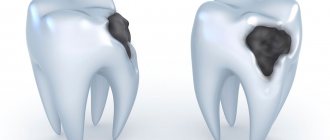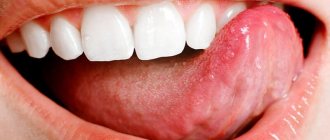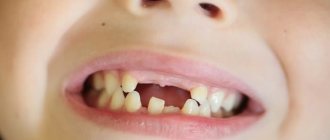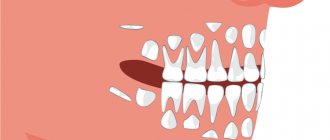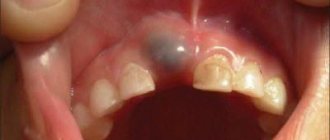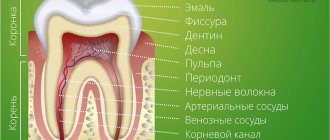In pediatric dentistry, one of the most common reasons for visiting a doctor is black plaque on a child’s baby teeth. It can appear at any age, and sometimes completely unexpectedly: some parents say that the baby went to bed with normal teeth, and woke up with noticeable blackening. Why do young children’s teeth turn black, what should be done in such cases, and how dangerous is this blackening?
What is Priestley plaque on teeth?
This is a dental problem that occurs in children. In this condition, deposits are found on the enamel of the teeth. Dark plaque on a child’s teeth can be black or brown, sometimes with a light or pearlescent tint. As a rule, it is located as a thin border along the lower edge of the teeth closer to the gums. But plaque can also cover a large area of the tooth or look like a small spot on the enamel. Most often, dark deposits appear on the inside of the teeth, less often in the interdental space or on the outer surface of the teeth.
Photo courtesy of InWhite Medical Clinic
Causes of darkening of teeth
Why do my child's teeth turn black? This process can be caused by several reasons:
- early caries;
- poor absorption of calcium by the body;
- plaque;
- insufficient salivation;
- hereditary factors;
- chronic diseases;
- fungus of the gastrointestinal tract;
- dysbacteriosis;
- the predominance of foods containing large amounts of sugar in the diet;
- disturbance of fluoride metabolism;
- metabolic disease;
- parents sharing cutlery with their children, licking the child's pacifier or kissing on the lips;
- taking medications containing iron;
- insufficient formation of enamel.
There are many reasons why teeth can darken, but especially often the darkening begins due to childhood caries caused by one of the following factors:
- mechanical (shocks or injuries);
- chemical;
- thermal (temperature difference: eating hot food and immediately cold food and vice versa);
- bacterial (development of oral bacteria)
How to detect dark plaque in time
- regularly examine the child’s oral cavity independently;
- do not postpone scheduled visits to the dentist.
It must be taken into account that Priestley plaque on the teeth often accumulates slowly, which is why the child gets used to the stains on the enamel and does not tell his parents about them. Darkening of teeth can occur quickly, literally overnight. Reactive appearance most often occurs during illness, accompanied by intoxication, dehydration and increased body temperature. This is due to the fact that the child’s body reacts sharply to various changes in diet, the functioning of internal organs and in external conditions.
Deposits most often occur at the age of 2-3 years. However, they can also appear on the very first milk teeth of a one-year-old child. Or it could affect the baby teeth of a younger teenager who haven’t had time to change. The darkening may also spread to permanent teeth.
Why is this happening?
Sometimes treatment allows you to regain lost whiteness, and sometimes the changes are irreversible, but this process still cannot be ignored. The main thing is to correctly determine the cause.
- Poor or lack of oral hygiene. Plaque of food debris on the surface of the enamel thickens over time and absorbs dyes, which leads to blackening.
- Regular consumption of drinks and foods containing dark food pigments.
- Unhealthy diet, vitamin deficiency and the predominance of sweets in the diet.
- Development of caries. A small dark spot quickly increases in size, and if the carious cavity deepens inward, the internal affected areas turn black.
- Due to trauma, the vascular bundle inside the pulp is sometimes damaged. The hematoma gives the tooth a characteristic dark shade.
- Taking certain drugs, for example antibacterial ones from the tetracycline group, also leads to blackening of the enamel. The medicine accumulates in the tissues - even the first tooth may be black.
- Also, teeth turn black after silvering - applying a solution with silver ions to the caries-affected surface.
Why does a child have black plaque on his teeth?
The main problem with the appearance of Priestley plaque on teeth is not that it causes bad breath, looks unsightly, or cannot be removed independently without the help of a hygienist. Priestley's plaque is a signal that something has changed in the child's body, due to which non-dangerous bacteria began to actively multiply, creating deposits. And for high-quality treatment and prevention of the development of diseases, it is necessary to find out why black plaque forms on the teeth, the reasons for the appearance of beneficial living conditions for bacteria.
Possible causes of plaque:
➢
diabetes;
➢
genetic feature or hereditary predisposition;
➢
thyroid diseases;
➢
incorrectly selected hygiene products;
➢
parasite infection.
Dysbacteriosis.
Disruption of the gastrointestinal tract can occur due to malnutrition, food poisoning, immaturity of the digestive system, taking antibiotics or chronic diseases of the stomach, liver, and intestines.
Caries.
Due to the fact that parents usually do not brush their baby’s first teeth, yellow plaque begins to accumulate on the enamel, which over time can cause caries. Irregular or insufficiently high-quality tooth brushing by the child himself also leads to the formation of caries. Carious lesions create a favorable environment for the growth of bacteria, which causes Priestley plaque to appear on baby teeth.
Dehydration.
Due to dehydration due to various reasons, the body cannot produce enough saliva to wash the teeth and remove food particles. Because of this, bacteria begin to multiply faster, and a dark plaque forms on the child’s teeth. Therefore, it is important to ensure that your baby gets enough fluids, especially in hot weather or during illness.
Hypoplasia of tooth enamel.
Some children have underdeveloped top layer of enamel. It is weakened and unable to perform a protective function.
Disorders of dental development in the prenatal period.
Dental buds may be damaged during development due to viral infections suffered by the mother, calcium deficiency, iron deficiency, or taking certain medications.
Improper functioning of the immune system.
Malfunctions in the immune system can affect the body's ability to suppress bacterial activity.
Malocclusion.
If a child has a malocclusion, the load on the jaw when chewing is distributed unevenly, which is why some of the teeth receive increased load, but are cleansed with solid food: carrots, apples. And unused teeth become covered with plaque.
Disease prevention
Preventive measures to prevent the development of dental diseases and the formation of plaque should be applied from the moment the baby first starts teething. The risk of unpleasant problems occurring can be significantly reduced by the following simple measures:
- Gentle oral care. Infants up to one year old can clean their gums with a cotton pad soaked in a decoction of chamomile, string, oak bark or sage. Special silicone attachments are also widely popular, which adults put on their fingers and thus clean the baby’s oral cavity. From the age of two, children must be taught to brush their teeth with a brush and toothpaste, and it is also advisable to rinse the mouth after each meal.
- Proper nutrition. This does not imply following any diets, but the child’s nutritional system should be designed in such a way as to limit his intake of sweets, sugar, confectionery and increase the consumption of healthy natural products. Sweets from the store are an excellent substitute for candied fruits, fruits and dried fruits.
- Timely abandonment of pacifiers and bottles. With prolonged use of a bottle or pacifier, an incorrect bite develops, dependence on accessories appears, and a black plaque forms, which in dentistry is called “bottle caries.” You should not delay in weaning your child off devices that he no longer needs.
- Maintaining the immune system. It is important to ensure that even in winter, the child has enough vitamins to maintain healthy teeth and the body as a whole.
By following these simple recommendations, you will ensure your child’s dental health and the beauty of a child’s smile.
return to list of articles
Diagnosis of Priestley plaque on teeth
If darkening is detected on the enamel of a child’s teeth, you must contact a dental clinic.
The specialist will:
✔
inspection;
✔
laser diagnostics to determine the depth and size of the lesion;
✔
anamnesis collection.
After a conversation with the parent and child and collecting an anamnesis, the pediatric dentist will immediately prescribe treatment or conduct an additional examination. You should not neglect it - it is important for a specialist to find out why the child has black plaque on his teeth. Only after this will he be able to provide quality treatment.
Can teeth turn black not due to caries?
In very rare cases, teenagers may experience darker tooth color if their daily diet includes a lot of soy sauce, coffee, tea, potatoes, or drugs containing fructose. However, such “darkness” is not at all similar to carious lesions and is easy to distinguish.
Do rotten teeth need to be treated?
Undoubtedly. Remember: the opinion that there is no need to treat baby teeth “because they will fall out anyway” is fundamentally wrong and even criminal. Firstly, caries in baby teeth spreads very rapidly: a couple of months ago the child simply had rotten teeth, and today he is already screaming and crying from pulpitis.
Secondly, untreated caries of a baby tooth can cause inflammation of the soft tissues, the appearance of an abscess, as well as such serious consequences as:
- Sepsis;
- Meningitis;
- Damage to large blood vessels in the neck area;
- Otitis;
- Sinusitis;
- Stomach pain, intestinal disorders, stool disorders and other gastrointestinal diseases.
Thirdly, advanced caries and tooth decay can lead to premature loss of a baby tooth, and subsequently to disruption of the even dentition of molars. Don’t forget that a rotten baby tooth can “infect” a molar tooth with caries.
Don’t forget about children’s complexes: rotten teeth look unsightly and cause significant discomfort to the baby.
How to spot rotting at an early stage?
In order not to go through all the horrors of treating rotten teeth with your beloved daughter or son, be able to recognize the first signs of caries in time:
- The characteristic “rotten” odor from a child’s mouth indicates the presence of cavities.
- Small yellowish spots on the teeth are the first stage of caries.
- A child’s complaints about discomfort when drinking cold, hot and sweet drinks and foods indicate thinning of the enamel.
- The characteristic black spots on the teeth are caries that need to be treated.
Do not forget that it is better to treat caries at an early stage, because it will be much more difficult to eliminate the problem of rotten teeth later.
How to cure rotten teeth?
To cure rotten teeth in a child means taking the baby to the dentist. If the baby’s teeth have already turned black, it is useless to treat them with folk remedies. A variety of balms, rinses and masks can only slow down caries.
An experienced dentist treats rotten teeth in children in stages:
- The doctor examines the oral cavity, identifies areas of caries and inflammation of the gums, and, if necessary, sends the child for an x-ray.
- Teeth are cleaned and caries is treated. If lesions have been identified in several teeth, the doctor draws up a treatment regimen. Milk teeth that cannot be cured are removed.
- To disinfect affected gums, the doctor may prescribe special rinses with herbal decoctions; in rare cases, antibiotics are prescribed to destroy the infection.
Parents should not forget that it is not enough to just cure rotten teeth. It is important to eliminate the cause of caries, otherwise in a couple of months the baby will end up in the dentist's chair again. For example, if the doctor said that the cause of caries lies in the gastrointestinal tract, it is important to visit a gastroenterologist with your child. If the teeth begin to rot because the baby is leaning on candy and soda, reconsider the diet.
There are alternative ways to treat teeth that are slightly affected by caries:
- Remineralization. The dentist strengthens the surface of the teeth with a special mineral composition.
- Silvering. If the child does not allow a filling to be placed, and the tooth is not severely affected by caries, the doctor can strengthen the damaged surface with a solution of silver nitrate.
- Laser therapy. In rare cases, shallow caries can be treated with a laser.
- Deep fluoridation is effective for minor enamel damage. After this procedure, the teeth are saturated with useful minerals for a long time.
- Ozonation for mild caries can clean the rotten row from pathogenic microorganisms.
How to prevent the appearance of rotten baby teeth?
To prevent the child’s teeth from rotting and the dental drill from marring the joyful moments of childhood, it is important to carry out proper caries prevention.
1. Be attentive to your baby
Examine your child’s teeth every two to three days and if characteristic carious cavities appear, immediately make an appointment for the baby to see a doctor.
2. Visit your dentist regularly
Even if you have not noticed any changes in your child’s oral cavity, be sure to take him to the doctor on a preventive basis. The pediatric dentist should be visited twice a year. An experienced specialist can even notice the beginning of caries, which appears as a light spot on the tooth. If caries is detected in a timely manner at an early stage, the doctor can slow down or stop its development using an enamel remineralization procedure.
It is recommended to visit the dentist in the morning, when the baby is alert and calm, and most importantly, has not yet had time to “work up” himself with fears.
3. Strengthen your enamel
Of course, the baby does not need to take antibiotics and anti-inflammatory drugs without a doctor’s prescription. However, you can completely strengthen your child’s enamel with natural ingredients, for example, rinse the mouth with herbal decoctions - oak bark, sage, calendula. These herbs have excellent anti-inflammatory, calming effects.
4. Watch your diet
Believe me, kids in adolescence and young adulthood will have time to eat plenty of chips and drink soda. But in early childhood, you can completely control the diet of your kids. Make sure that your child does not consume a lot of sweets and sours, give the baby more vegetables and fruits - fresh fruits are magic boxes of vitamins and help to naturally cleanse teeth. And, of course, give your child more milk, cottage cheese, kefir and other goodies from cows and goats.
How to properly brush baby teeth?
Teaching a child to take care of his teeth from childhood means ensuring him a happy adolescence and youth without toothache. And caring for your teeth means, first of all, proper brushing. Until the age of 3, it is better to help the child with this procedure, but after three, you can trust the child to brush his teeth on his own.
Remember:
- Teeth need to be brushed from top to bottom - this is the only way to remove the plaque that has formed.
- You need to brush your teeth for at least 2 minutes. Try placing an hourglass in your baby's bathroom, which will teach him to carry out the procedure for a long time. After finishing cleaning, rinse your mouth.
- Children, like adults, should brush their teeth twice a day - morning and evening, before bed. It is important to rinse your mouth after every meal.
To make the process of brushing teeth enjoyable for your baby, it is important to carefully choose toothpaste. For example, ASEPTA BABY gel toothpaste can be used for babies from 0 to 3 years old. The soft gel gently cares for your child's teeth and gums without damaging them. The natural components of the paste provide protection against caries and inflammatory processes in the oral cavity; the bright taste of “tutti-fruiti” makes cleaning a delicious adventure. But the main thing is that “ASEPTA BABY” does not contain abrasives, fluorine, parabens, or sodium lauryl sulfate.
We hope our recommendations for caring for children's teeth and caries treatment will be useful to you. And rotten teeth will never bother either kids or their parents.
Additional protective measures for Priestley's raid
It is possible that Priestley's plaque on the teeth appeared due to an infection and, as a result, a temporary deterioration in the functioning of the immune system. But it is necessary to make sure that there are no serious and dangerous deviations in the child’s health. Therefore, if dental plaque is detected, the dentist will recommend taking additional measures:
- get tested for the presence of parasites in the body;
- consult a gastroenterologist;
- take tests to check the level of iron and calcium in the body;
- check your blood sugar levels.
These measures will help identify the problems that are causing plaque to form on your teeth.
How to remove black plaque on teeth
It is impossible to remove dental plaque at home. Moreover, the use of abrasive agents and intense exposure to teeth with a brush can cause an increase in dental problems: thinning or damage to the enamel, trauma to the gums or mucous membrane.
Priestley's plaque on children's teeth can only be removed in a well-equipped dental clinic. The specialist will:
- professional teeth cleaning;
- If necessary, treat the teeth with a remineralizing composition.
If plaque formation is caused by dental problems, additional treatment may be prescribed, including bite correction.
The doctor will also select a home hygiene kit that is ideal for the child: a toothbrush of the correct shape and hardness, toothpaste with the optimal composition, and mouth rinse. Additionally, the hygienist will teach the child how to brush their teeth correctly and will talk about the need for quality oral care.
Taking into account the causes of the disease, the dentist may prescribe additional treatment measures, for example, recommend dietary supplements, dietary nutrition, avoidance of drinks and foods with dyes that affect the color of the enamel.
The importance of healthy baby teeth
Many parents are convinced that treatment of baby teeth is not so important, since these are not molars. However, they are wrong: the last milk teeth fall out in children aged 12-13 years, and if up to this point the milk teeth were lost, for example, due to caries, then the long-term absence of teeth, in the place of which permanent ones later grow, leads to the formation of incorrect bite In addition, the fact how healthy the permanent teeth will be directly depends on whether the baby teeth were carefully looked after in childhood. You can prevent the development of caries by not ignoring visits to the dentist at least twice a year and proper oral hygiene.
